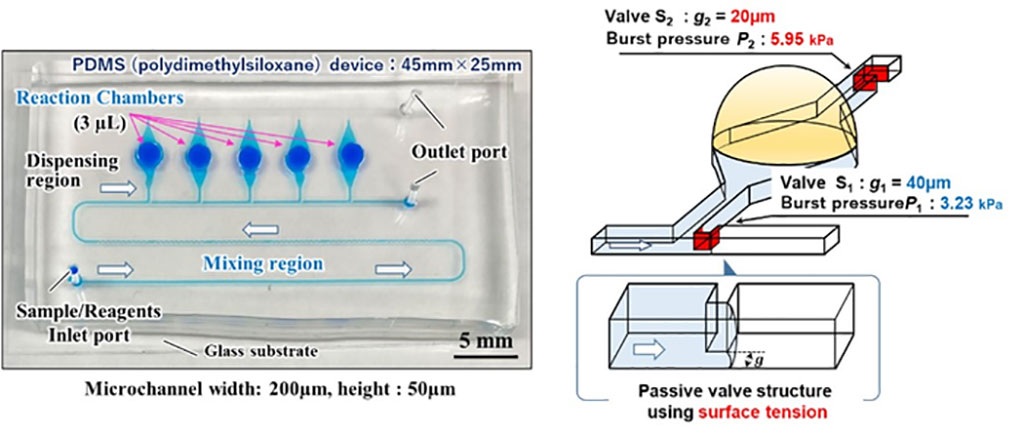Microfluidic Chip Enables Simultaneous Diagnosis of COVID-19 and Influenza Diseases
Posted on 06 Jan 2022
A research team has developed a microfluidic chip that is capable of simultaneous diagnosis of COVID-19 and influenza diseases, by applying the microfluidic chip technologies.
Researchers from the Toyohashi University of Technology (Toyohashi, Japan) and Jikei University School of Medicine (Tokyo, Japan) built a theoretical model that manipulates microfluidic flow with an extremely simple microchannel design and has established an optimal design theory for microfluidic chips. Further, by using the diagnostic device they developed, they performed genetic amplification experiments on four types of infectious diseases, including COVID-19, and demonstrated that multiplexed rapid and simultaneous diagnosis was possible within 30 minutes. The device can be utilized for genetic diagnoses in a range of fields (e.g. agriculture, farming, and fisheries industries, food industry, and health and medical care), not only human infectious diseases. The diagnostic technology can enable anyone, anywhere, any time to detect viral diseases in a rapid, simple, and low-cost way.

The LAMP (Loop-Mediated Isothermal Amplification) method is a genetic test technology. This simple test method does not require an expensive accurate temperature control equipment, etc., in contrast to the widespread PCR test, and can be conducted on site because it allows genetic amplification at a constant temperature for a constant length of time (60 to 65℃, 30 minutes to an hour or so). However, to diagnose multiple types of viruses, the conventional LAMP method entails considerable effort to perform as many preparations of samples and reagents and genetic amplification reactions as the number of analytes, requiring expert knowledge and skills.
Therefore, the research team developed a polydimethylsiloxane (PDMS)-based multiplexed genetic diagnostic device (size: 45mm x 25mm, reaction chamber: 3µL x 5 pieces) by applying the microfluidic chip technology. It autonomously, equally, and accurately dispenses samples and reagent into an array of reaction chambers simply by introducing the liquid, a mixture of an extremely small amount of sample extracted from the analytes and a reagent, into the diagnostic device. By heating the device in warm water (at 60 to 65℃, for 30 minutes to an hour or so), it is capable of simultaneous diagnosis of multiple types of viruses with only one operation (one work process per sample).
The genetic diagnosis result showed that four types of infectious diseases including the COVID-19 (seasonal influenza A, SARS, and influenza H1N1 pdm09) were successfully detected with this diagnosis device. Only the reaction chamber that reacted when a sample containing the gene of each virus was introduced turned sky blue (denoting a positive reaction) after 30 minutes, which means that visual detection is possible.
In addition, to support on-site diagnoses, the team has developed a smartphone app, which automatically diagnoses the reaction as positive or negative based on photographs taken with a smartphone camera. The diagnosis device is capable of easy automatic test result diagnosis (positive or negative), by placing the device after LAMP reaction in a simple LED illumination device and taking photographs with a smartphone. As a result, it is expected that anyone will be able to easily perform the test, anywhere and anytime. In the future, aiming to commercialize the diagnosis device, the research team will develop devices capable of multiplexed rapid diagnosis of variants of the COVID-19 and human infectious diseases for a safe life during and after the COVID-19 pandemic.
Related Links:
Toyohashi University of Technology
Jikei University School of Medicine














